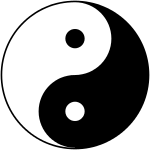As everything is always moving and changing, things with yin qualities are constantly becoming more yang, while yang becomes more yin. This is the basic Chinese understanding of every cycle of nature: the sun shines out (yang), then sets (yin); the moon waxes (yang) and wanes (yin); the summer changes to autumn and winter changes to spring.
The Yijing, Book of Change, works in the same way: the two kinds of line can change into one another. So when you consult the Yi, your answer begins as a single primary hexagram, capturing the essence of what’s involved – but you might also ‘catch’ any one of its six lines in the moment of changing into its opposite.
So from the two kinds of line, there are four distinct energies that can be present:
| Young yin, which has just become yin and will be stable for a while: | |
| Old yin, which is just changing into yang: |  |
| Young yang, newly yang and stable for now: |  |
| Old yang, changing into yin: |  |

The tai ji (Great Pole) symbol may be some two thousand years younger than Yi’s changing lines, but it represents the same concept: yin and yang change into one another ceaselessly, and each contains the seed of the other.
The hexagram of your answer can contain any combination of these kinds of line. Usually one or two lines are changing their state; sometimes none change; very occasionally, everything is in flux and all six are changing.
When lines change…
Associated with every line of the Yijing is a ‘line text’. If a line is changing, or ‘moving’, you read its text: an image telling you exactly where you stand (or might choose to stand) in relation to the landscape painted by the hexagram as a whole.
Moving lines also show you a further perspective on your question: the relating hexagram. When every moving line in a reading changes to its opposite – broken becoming solid, solid becoming broken – this reveals a second hexagram – like this:

becoming

You call the hexagram you cast the primary hexagram and this second, underlying one the relating hexagram. It tends to show where you stand in relation to the original, primary hexagram, and the moving lines ‘light up’ to show where and how this relationship works.
Apply: quick quiz
This quiz is for logged in users only.









